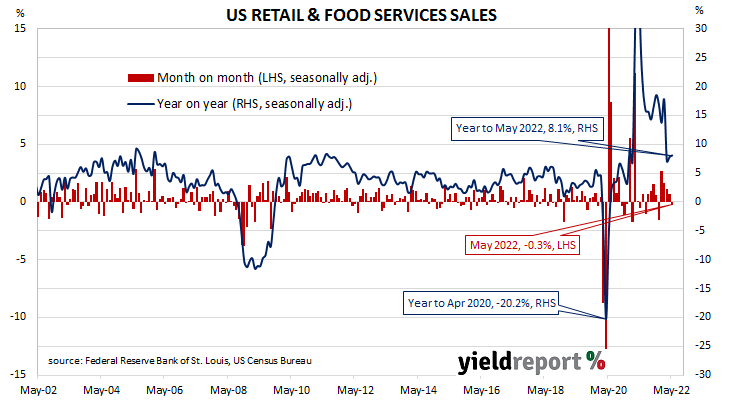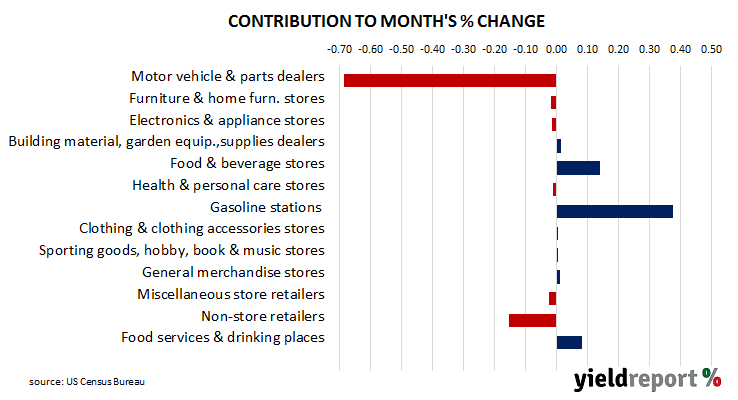Summary: US retail sales down 0.3% in May, lower than expected; April figure revised down; points to slowing consumer demand; US Treasury bond yields fall, rate rise expectations soften; auto sales slump, various core measures undershoot expectations; falls in six of thirteen retail categories; vehicles & parts” segment again largest single influence.
US retail sales had been trending up since late 2015 but, commencing in late 2018, a series of weak or negative monthly results led to a drop-off in the annual growth rate below 2.0%. Growth rates then increased in trend terms through 2019 and into early 2020 until pandemic restrictions sent it into negative territory. A “v-shaped” recovery then took place which was followed by some short-term spikes as federal stimulus payments hit US households in the first and second quarters of 2021.
According to the latest “advance” numbers released by the US Census Bureau, total retail sales declined by 0.3% in May. The fall contrasted with the 0.2% gain which had been generally expected as well as April’s 0.7% after it was revised down from 0.9%. However, on an annual basis, the growth rate still accelerated from April’s revised figure of 7.8% to 8.1%.
“Retail sales account for about 35% of US private consumption, so the data point to a slowing in consumer demand and the need to get inflation down to support real consumption growth,” said ANZ economist Madeline Dunk.
US Treasury bond yields dropped on the day after the US Fed announced a 75bps rise of its federal funds rate target range. By the close of business, the 2-year Treasury yield had shed 19bps to 3.21%, the 10-year yield had lost 20bps to 3.28% while the 30-year yield finished 10bps lower at 3.33%.
In terms of US Fed policy, expectations of higher federal funds rates over the next 12 months softened noticeably. At the close of business, July contracts implied an effective federal funds rate of 1.685%, 10bps higher than the newly-raised spot rate. September contracts implied 2.445% while July 2023 futures contracts implied an effective federal funds rate of 3.835%, 225bps above the spot rate.
“Auto sales slumped 3.5% but various core measures also undershot expectations,” said Ray Attrill, Head of FX Strategy within NAB’s FICC division. “These nominal sales look even weaker when adjusted for still-strong inflation.”
Six of the thirteen categories recorded lower sales over the month. The “Motor vehicles & parts dealers” segment again provided the largest single influence on the overall result, falling by 3.5% for the month and by 3.7% over the year to May. “Non-store retailer” sales decreased by 1.0% over the month but increased by 7.0% over the year to May.
The non-store segment includes vending machine sales, door-to-door sales and mail-order sales but nowadays this segment has become dominated by online sales. It now accounts for just over 15% of all US retail sales and it is the second-largest segment after vehicles and parts.



